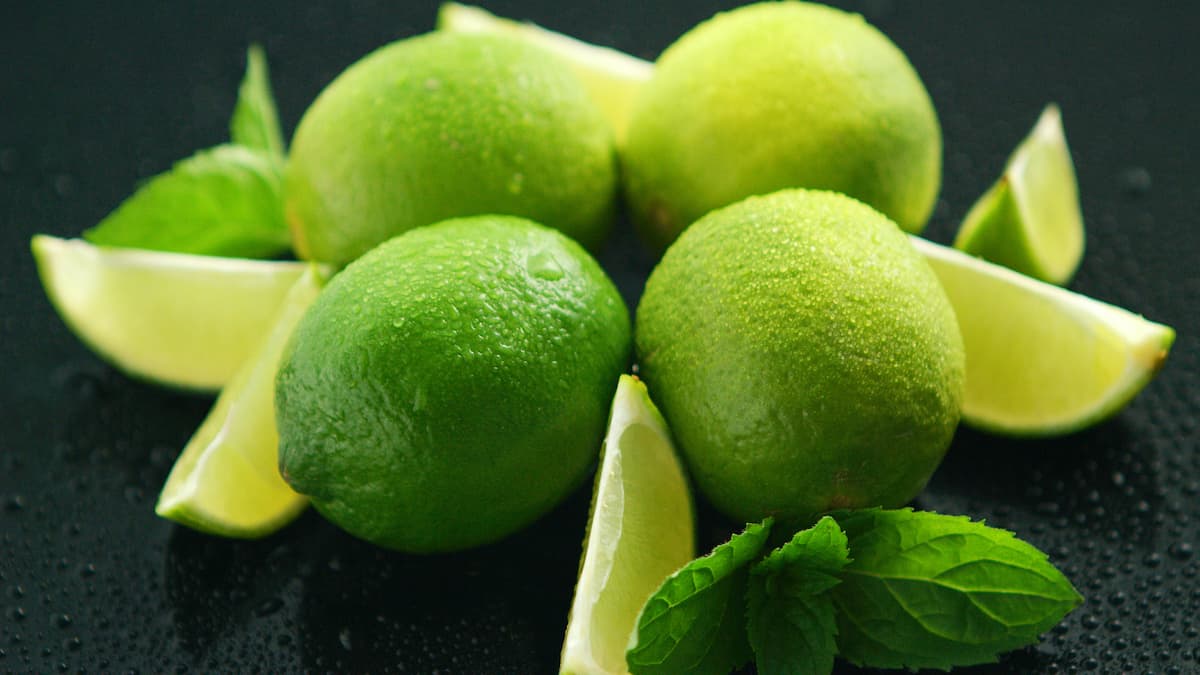Can you freeze limes? Whether you have an abundance of limes from your garden or found a great deal at the grocery store, freezing them can be a convenient way to extend their shelf life and ensure you always have this zesty citrus fruit on hand. This article will delve into freezing limes, exploring the benefits, methods, and potential considerations to help you make the most out of your lime preservation efforts.
Can You Freeze Limes?
Yes, you can freeze limes. Freezing limes is a great way to preserve their freshness and flavor for longer. Frozen limes can be used directly in recipes or thawed for use in beverages. However, keep in mind that freezing may slightly alter the texture of the lime, making it softer when thawed. It is important to note that freezing limes is not recommended for those who primarily want to use them for their juice, as freezing can affect the juiciness of the fruit.

Benefits Of Freezing Limes
Here are some of the benefits of freezing limes:
- Freezing limes helps preserve their freshness and flavor for an extended period.
- Frozen limes are readily available whenever needed, eliminating the need for frequent trips to the grocery store.
- Frozen limes can be used in various recipes, including beverages, desserts, dressings, and marinades.
- By freezing limes when they are in season or on sale, you can save money compared to purchasing them at higher prices during off-seasons.
- Freezing limes allows you to use them before they spoil, reducing food waste.
- With frozen limes, you can enjoy their tangy flavor and nutritional benefits all year round, regardless of their seasonal availability.
Steps To Freeze Limes
Freezing limes is a simple and effective way to preserve their freshness and flavor for an extended period. Following the steps outlined below, you can ensure your limes stay delicious and ready to use whenever needed.
Step 1: Selecting Fresh Limes
Start by choosing fresh, ripe limes. Look for limes that have a vibrant green color and feel firm to the touch. Avoid limes that are soft, discolored, or have any signs of mold or decay.
Step 2: Washing the Limes
Before freezing, it is important to wash the limes thoroughly to remove any dirt, bacteria, or pesticides that may be present on the skin. Rinse the limes under cool running water while gently rubbing them with your hands. This will help remove any surface impurities.
Step 3: Drying the Limes
After washing, pat dry each lime with a clean kitchen towel or paper towel. Ensuring that the limes are completely dry will prevent ice crystals from forming on their surface during freezing, which can affect their texture and taste.
Step 4: Slicing or Juicing (Optional)
At this stage, you can freeze whole limes or prepare them for specific uses by slicing or juicing. If you plan to use frozen lime slices in drinks or recipes, slice the limes into thin rounds. Alternatively, if you prefer to have lime juice readily available, squeeze the juice from the limes into a separate container.
Step 5: Packaging for Freezing
To prevent freezer burn and maintain optimal quality, it is essential to package the limes properly before freezing. There are a few different methods you can choose from:
Freezing whole limes, slices, and juice involves placing them in a resealable plastic bag or airtight container, ensuring minimal air to prevent freezer burn. Once partially frozen, transfer the slices to a resealable plastic bag and label the freezing date. Lime juice can be frozen in ice cube trays or small freezer-safe containers, covering them with plastic wrap or lids.
Step 6: Freezing and Storage
Place the packaged limes in the freezer, storing them flat to prevent them from sticking together. It is recommended to store limes at a temperature of 0°F (-18°C) or below for optimal preservation.
Step 7: Thawing and Usage
There are a few different thawing methods when you need frozen limes. To make fresh lime juice, thaw whole limes overnight, slice them at room temperature, or add them to drinks or recipes. Thaw lime juice cubes or containers in the refrigerator or at room temperature.
Freezing Whole Limes
To freeze the whole limes, follow the steps mentioned below:
- Select fresh, ripe limes with no blemishes or soft spots.
- Wash the limes thoroughly under running water to remove any dirt or residue.
- Pat dry the limes using a clean towel or paper towels.
- Place the whole limes in a resealable plastic bag or an airtight container.
- Squeeze out as much air as possible from the bag or container before sealing it.
- Label the bag or container with the freezing date to keep track of freshness.
- Place the limes in the freezer and ensure they are stored in a flat position.
- Allow the limes to freeze completely, which usually takes 4 to 6 hours.
- Once frozen, the limes can be stored for up to 3 months.
- To thaw the frozen limes, transfer them to the refrigerator and let them thaw slowly overnight.
- Alternatively, you can use frozen limes directly in recipes that require their juice or zest without thawing.
Freezing Lime Wedges
To store lime wedges:
- Start by selecting fresh and ripe limes.
- Wash the limes thoroughly under running water to remove any dirt or residue.
- Pat dry the limes using a clean kitchen towel or paper towel.
- Cut the limes into wedges by slicing them in half lengthwise, then cutting each half into smaller wedges.
- Remove any seeds from the lime wedges if desired.
- Place the lime wedges on a baking sheet lined with parchment paper or a silicone mat, ensuring they are not touching each other.
- Place the baking sheet in the freezer and let the lime wedges freeze completely. This usually takes around 2 to 4 hours.
- Once frozen, transfer the lime wedges into airtight freezer bags or containers. Label them with the date of freezing for future reference.
- Return the bags or containers to the freezer and store them for up to 3 months.
Freezing Lime Juice
Here is how you can freeze lime juice:
- Squeeze fresh lime juice from ripe limes.
- Strain the juice to remove any pulp or seeds.
- Pour the lime juice into ice cube trays, filling each compartment about 3/4 full.
- Place the ice cube trays in the freezer and allow the lime juice to freeze completely.
- Once frozen, remove the lime juice cubes from the trays and transfer them to a freezer-safe container or bag.
- Label the container with the date and contents.
- Return the container to the freezer for long-term storage.
Tips For Freezing Limes
Here are some tips on how to freeze limes effectively:
- Freeze lime juice in ice cube trays to add freshness to drinks and dishes year-round.
- Blend lime juice with water to make a slushy consistency before freezing for a fun twist on margaritas or smoothies.
- Wrap lime wedges in plastic wrap or aluminum foil before freezing to keep them moist and prevent browning.
- Freeze whole limes for zesting later or to add a pop of color to cocktails and desserts.
- Label and date all frozen lime packages for easy identification and organization.
- Consider using a vacuum sealer to remove air from the packaging before freezing for a longer shelf life.
- Keep frozen limes in an airtight container or freezer bag to maintain quality and prevent freezer burn.
- Thaw frozen limes in the refrigerator overnight or let them sit at room temperature for a few hours before using.
Conclusion
In conclusion, limes can be frozen to preserve their freshness and extend their shelf life. Freezing limes is a simple and effective method that allows you to enjoy the tangy flavor and nutritional benefits of limes for an extended period. By properly preparing and packaging the limes before freezing, you can ensure that they retain their texture, taste, and nutrients. Whether you want to freeze whole limes, lime juice, or zest, following the correct procedures will help maintain their quality. However, it is important to note that while frozen limes can be used in various recipes and beverages, they may lose some of their original texture and are best suited for cooking or juicing purposes rather than being consumed fresh.
Explore More Topics About Can You Freeze?
FAQs
Is It Better To Freeze Limes Whole Or Cut?
It is better to freeze limes whole, as cutting them before freezing can cause a loss of juice and flavor.
Can You Freeze Fresh Lime Slices?
Yes, you can freeze fresh lime slices. However, it is important to note that freezing may alter the texture and taste of the lime slices.
How Do You Defrost Frozen Limes?
To defrost frozen limes, place them in the refrigerator overnight or run them under cold water until they thaw.
What Is The Best Way To Preserve Limes?
The best way to preserve limes is by storing or freezing them in the refrigerator. You can also preserve limes by canning them in the form of lime juice or zest.
Can You Freeze Lime Zest?
You can freeze lime zest to extend its shelf life and preserve flavor. Place the zest in an airtight container or freezer bag and store it in the freezer for up to 6 months.
Can You Freeze Lime Juice?
Yes, lime juice can be frozen for long-term storage. However, it is important to note that the texture and flavor of the juice may slightly change after freezing.
Can You Freeze Lime Slices?
Yes, you can freeze lime slices. Place the slices in an airtight container or freezer bag and store them in the freezer for up to 3 months. When ready, thaw the slices in the refrigerator or use them directly in recipes.
How Long Do Limes Last In The Fridge?
Limes can last up to 2-4 weeks in the fridge. However, their quality may need to improve after the first week.






